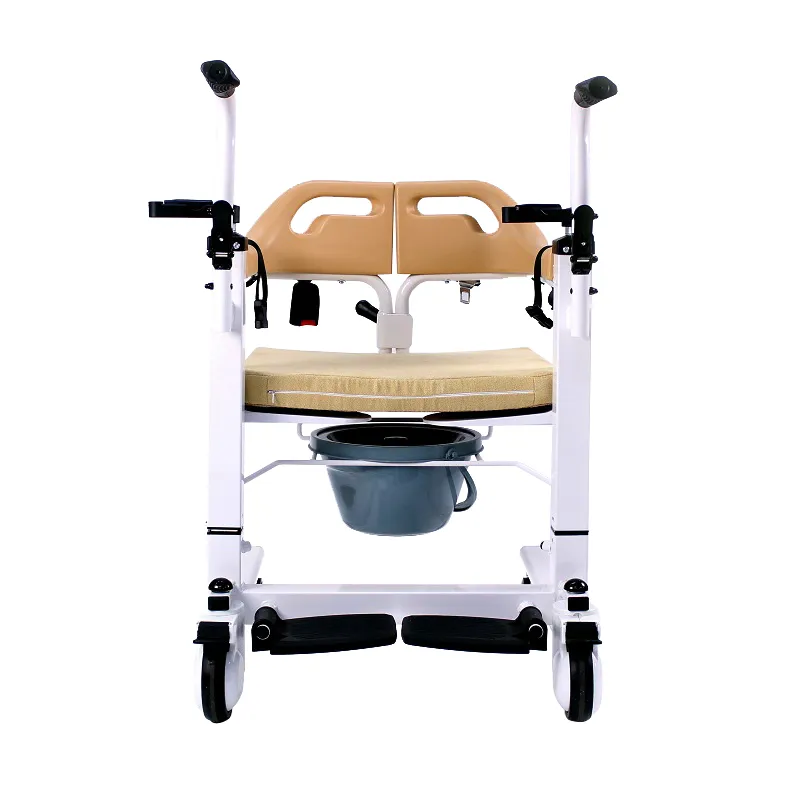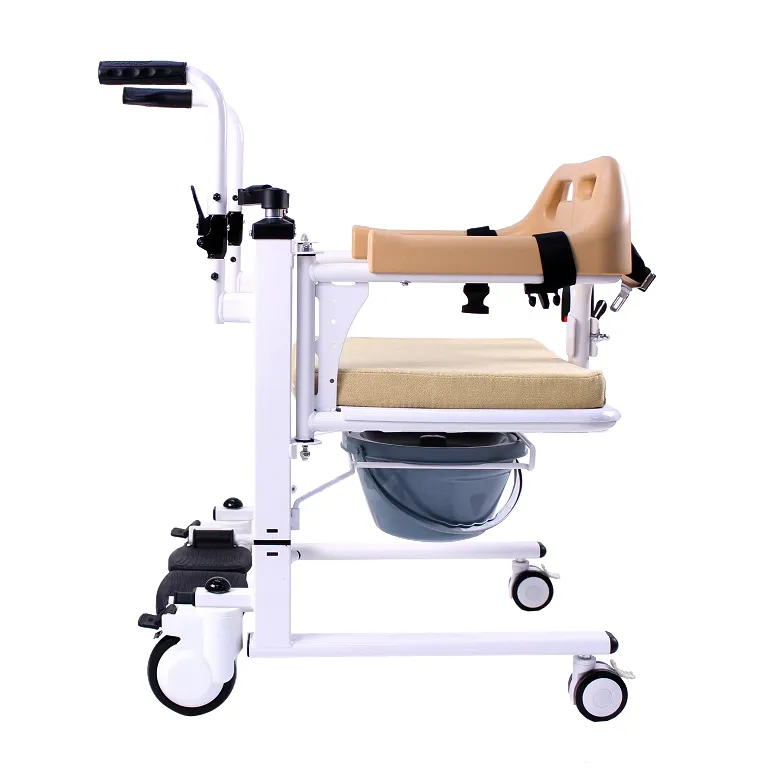With the aging population becoming increasingly serious, more and more families, rehabilitation institutions, and hospitals are facing a practical challenge: how to efficiently, safely, and dignifiedly transport patients with limb weakness. This issue not only affects the dignity and comfort of patients but also directly impacts the workload, safety, and efficient allocation of medical resources by caregivers.
As transfer methods continue to evolve, the patient transfer lift chair has become an essential and indispensable tool.
This article will address the challenges of transporting patients with limb weakness and comprehensively analyze existing mainstream transfer methods, specifically the structure, functions, advantages, and suitable populations of the patient transfer lift chair. It will also compare the chair with other assistive devices, aiming to provide caregivers and medical professionals with a professional and practical transfer guide.
Patients with limb weakness: Who needs to be transported?
Limb weakness is a common clinical symptom with a wide range of causes, including:
· Sequelae of stroke
· Muscle atrophy and disability caused by advanced age
· Neurological diseases (such as Parkinson's disease and ALS)
· Bedridden individuals recovering from fractures
· Muscle atrophy caused by disuse due to long-term hospitalization or bed rest
Most of these individuals are unable to independently perform basic movements, such as moving from bed to chair, chair to toilet, and toilet to wheelchair, and require assistance. Improper transfer procedures can easily lead to:
· Patient falls or secondary injuries;
· Caregiver back injuries;
· Inefficient transfer, impacting the quality of care;
· Patient loss of dignity and psychological stress.
Therefore, selecting appropriate transfer methods and equipment for patients with limb weakness is a key step in improving the quality of care.

Comparison of Traditional Transfer Methods
Let's first examine common transfer methods and their limitations:
Transfer Methods | Advantages | Limitations and Risks |
| Manual Transfer with Support | Equipment-free, quick and easy | Caregiver injuries are highly likely, especially with heavier adult patients |
| Slide Board + Manual Lift | Assisted mobility, slides reduce friction | Manipulation still requires significant force from the caregiver, and there is a risk of dislodging or slipping |
| Medical Sling + Electric Hoist (Patient Lift) | Suitable for severely bedridden individuals, mechanical assistance is safer | Installation is cumbersome and time-consuming, and patients may be more fearful |
| Patient Lift Chair | Simple and safe, allowing for quick transfers | Relatively expensive and requires a certain amount of floor space, but highly practical |
Clearly, the patient lift transfer chair is currently one of the preferred options, combining safety, ease of use, and patient comfort, making it particularly suitable for both home and institutional care settings.
What is a patient transfer lift chair?
The patient transfer lift chair is a multifunctional nursing device that combines the functions of a wheelchair, commode, transfer machine, and lifting device. Designed for patients unable to move independently, it aims to simplify operation for caregivers and ensure patient safety. Core features include:
1. Adjustable lift system
A manual hydraulic or electric lift mechanism adjusts the seat height for easy docking with beds, toilets, wheelchairs, and other equipment.
2. Removable or retractable armrests and leg rests
Facilitate lateral transfers, reduce lifting and support, and improve efficiency.
3. Locking casters with brakes
Ensure stability and prevent slippage and falls.
4. Built-in commode system (optional)
Meets toileting needs and reduces movement.
5. Waterproof material design
Suitable for bathing environments or slippery areas, enhancing flexibility.
6. High-strength load-bearing structure
Most devices have a load capacity between 120-180 kg, meeting the needs of most patients.
✅ Function Summary:
· Transfer from bed to chair or toilet;
· Reduces risk of caregiver strain;
· Can be used for temporary bathing or defecation;
· Easy to maneuver and turn indoors;
· Flexible adaptation for home and institutional care.

How do patients with limb weakness use a patient lift transfer chair?
The following is an illustration of a typical transfer process:
① Transfer from bed to lift chair:
· Adjust the patient transfer lift chair to be flush with the bed;
· Unfasten the armrests (either folded outward or removed);
· A caregiver gently helps the patient to a seat;
· Close the armrests and footrest;
· Lower the seat height for a stable sitting position.
② Transfer from transfer chair to bath or toilet:
· Confirm the path is clear before locking the wheels;
· Adjust the chair back angle (some models can be tilted);
· Dock to a toilet or commode;
· Remove the seat cushion or open the commode lid if needed.
③ Returning from a chair to a bed or wheelchair:
· Raise the chair to the same height as the desired position;
· Remove the side armrests;
· Assist the patient in moving laterally or sliding to the desired position;
· Close the device and store it.
The entire process can be completed by one person, eliminating the need for collaboration, greatly improving efficiency and safety.
Which patients is the patient lift transfer chair suitable for?
The following groups are typical candidates for the patient transfer lift chair:
Patient Types | Advantages |
| Patients with hemiplegia after stroke | Enables smooth transfers with unilateral support |
| Patients recovering from fracture surgery | Reduces risk of reinjury and pain during procedures |
Elderly bedridden adults | Reduces the number of lifts and movements, improving nursing efficiency |
| Patients with Parkinson's disease/neurodegenerative diseases | Performs bathing and toileting even when control is poor and balance is unstable |
| Patients with muscle weakness due to prolonged bed rest | Maintains basic position changes and passive exercises |
Especially in long-term home care settings, the patient transfer lift chair can significantly reduce the caregiver's daily workload and is an irreplaceable and practical device.
Comparison of the patient transfer lift chair with other devices
Equipment Name | Difficulty | Usage Scenarios | Dependence on caregivers | Safety of Use | Price Range (USD) |
| Carrying, Supporting, and Transporting | High | Home/Emergency | High | Low | 0 |
| Sliding Pad or Slide Board | Medium | Between Bed and Chair | Medium | Medium | 100–200 |
| Patient Lift | Medium-High | Hospital/Nursing Facility | Medium | High | 800–3000 |
| Patient Lift Transfer Chair | Low | Bathroom and Toiletry at Home/Institution | Low | High | 500–2500 |
The above comparison shows that the patient lift transfer chair combines ease of use and safety, making it one of the most suitable devices for home care settings.

Patient transfer lift chair purchasing and maintenance recommendations
1. Choose a reputable brand or medical device manufacturer, such as Dayang Medical, to ensure reliable quality;
2. Prioritize models with brakes, padded designs, and non-slip handles;
3. Check for FDA certification or CE marking;
4. Keep it clean after daily use to prevent moisture corrosion;
5. Regularly check the lubrication of the lift mechanism and wheels.
Does Medicare cover patient lift transfer chairs?
As mentioned earlier, patient lift transfer chairs are not currently directly covered by Medicare as DME devices. However, there are two alternatives:
· Obtain a doctor's prescription for a "Patient Lift" and purchase a lift with a chair structure;
· Apply for special equipment reimbursement through a Medicare Advantage plan or commercial insurance.
Transferring is not just about carrying; care requires wisdom
"How should patients with limb weakness be transferred?" This isn't just a technical question; it's a practical one involving humanity, respect, and efficiency. Among numerous nursing devices, the patient lift transfer chair, with its efficient, safe, and user-friendly design, is becoming a mainstream choice for both homes and institutions. It's more than just a "mobility tool," but rather a crucial bridge that protects patient dignity and reduces the burden of care.
Where is Dayang Medical located?
Dayang Medical is located in Foshan, within the Guangdong-Hong Kong-Macao Greater Bay Area, China. Our location allows us to benefit from strong logistics, making our factory a reliable medical equipment supplier for global buyers.
We operate two modern R&D and production bases, ensuring large-scale supply capacity and competitive prices. As a China-based wheelchair and hospital bed manufacturer, we provide wholesale and customized services to customers worldwide.










